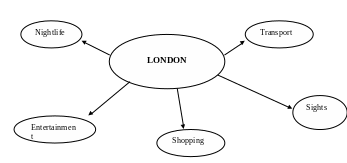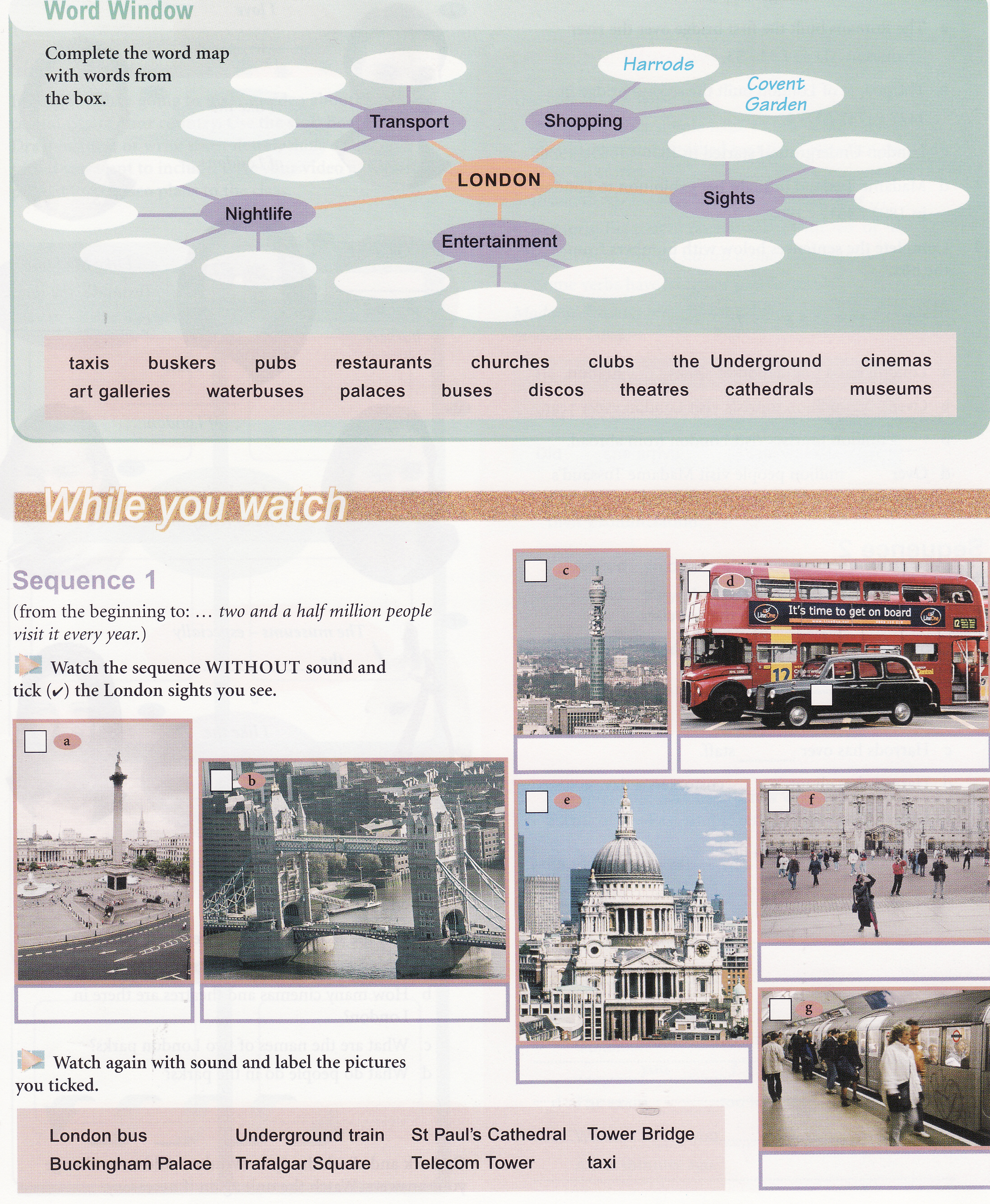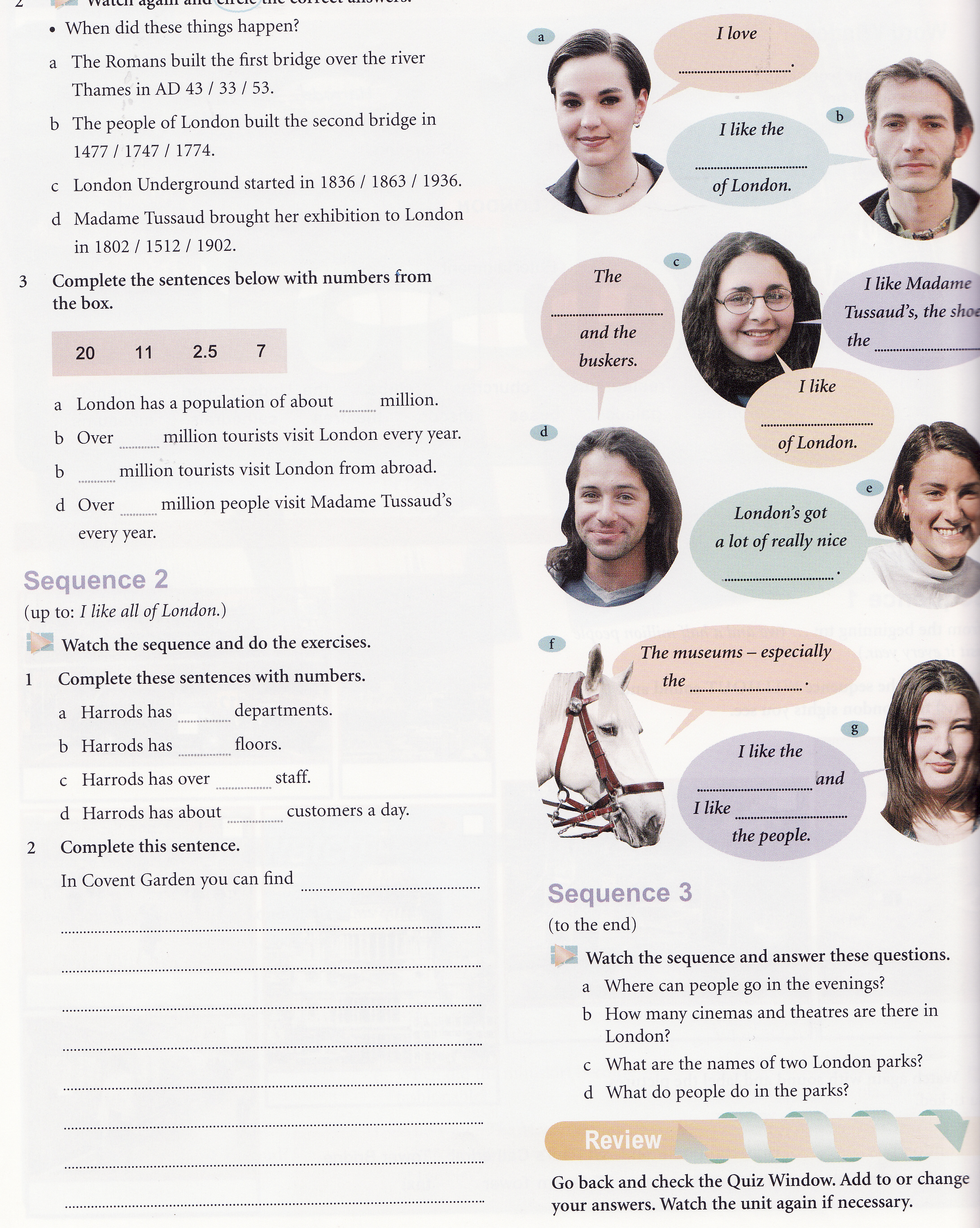
- •A view on britain
- •Contents
- •Part I the united kingdom of great britain and nothern ireland unit I
- •A) Look at the pictures. What parts of the uk do you think these plants symbolize?
- •Watch the sequence and match the parts of the uk with the national flags.
- •Watch the sequence again and fill in the missing information.
- •Watch the sequence, identify the places: Edinburgh, Stratford-upon-Avon, York, Liverpool, Cambridge and Oxford and make notes on each place.
- •Watch the sequence, tick the true sentences and correct the false sentences.
- •8. Read the text and check yourselves. Great britain
- •9. A) Unscramble the words.
- •10. Fill in the words from the list and then make sentences about your country using the completed phrases.
- •11. Name the tenses of the verbs in bold (1-5), and then match them to the uses (a-e)
- •16. These lines are from the email. Where do they go?
- •17. Write an email to book a room at the hotel.
- •1. A) Guess some political items.
- •A) Complete the scheme about the uk political system.
- •Political life
- •Match the numbers to the letters.
- •Use the words in bold to complete definitions 1-7.
- •Answer the questions using new vocabulary.
- •Part II london unit I
- •Complete the speech bubbles.
- •Watch the sequence and answer the questions.
- •Fill in the gaps with the names of popular attractions in London.
- •What are the parts of London?
- •Read the text to find out if your guess is correct. London
- •Now read the text again and for questions 1-5 choose the best answer: a, b or c.
- •13. Find words, phrases or expressions in the text which mean:
- •14. Match the numbers to the letters.
- •15. Put the verbs in brackets in the correct form.
- •16. Group work.
- •17. A) Listen to the directions, note them down and mark the route on the map.
- •Unit II
- •1. How much do you remember about London? Look at the pictures and try to match the names from the box with the sights.
- •2. Try to answer the questions about London sights, then listen and check your answers.
- •3. Play the part of a tourist guide. Show London sights to a group of tourists. Use the prompts:
- •4. Join the sentences with which or where.
- •5. Read about London and complete the text using the words in the box.
- •6. Write four paragraphs about your capital city. Begin each paragraph with the same words as in the text about London. Write 100-150 words.
- •Part III british towns bath
- •Supply the words with synonyms.
- •Make a choice between Present Participle and Past Participle:
- •Watch the film and arrange the statements in order of their appearance.
- •4. A) Watch the film and decide whether the statements are true or false.
- •Watch the film with sound turned off and make it sound yourself. Oxford
- •1. Fill in the blanks with the words from the box.
- •2. Watch the film and check your answers.
- •3. Watch the film and match the places of interest with the sets of words describing them.
- •Describe the sights using the active vocabulary.
- •You have a ticket to Oxford. Choose the places you want to visit and explain why. Cambridge
- •Match the words with their definitions.
- •Watch the film and complete the sentences with the active vocabulary.
- •Describe the sights enlisted below.
- •4. Show your friend round Cambridge.
- •Giving directions
- •A map of london
- •1. Say where in London you can:
- •2. Choose the best option.
- •3. Do the quiz. Choose a, b, c, or d.
- •4. Match beginnings to the endings.
- •5. Mark the statements as true or false.
- •6. Complete the article about the London Eye with the verbs in the brackets in either the active or passive form.
- •Vocabulary bank
- •Vocabulary bank
- •References
Part II london unit I
Lead-in
Complete the bubble-net.

Taxis buskers pubs restaurants churches clubs the Underground cinemas art galleries waterbuses palaces discos buses jewelry theatres cathedrals museums food fashionable clothes |
Watching
Watch the sequence and tick the sights you see.

Watch again and label the pictures.
London bus Underground train Tower Bridge taxi Telecom Tower St. Paul’s Cathedral Trafalgar Square Buckingham Palace |
Circle the correct answers.
The Romans built the first bridge over the river Thames in AD 43/33/53.
The people of London built the second bridge in 1477/1747/1774.
London Underground started in 1836/1863/1936.
Madam Tussaud brought her exhibition to London in 1802/1512/1902.
Complete the sentences below with numbers.
20 11 2,5 7 |
London has a population of about …million.
Over … million tourists visit London every year.
… million tourists visit London from abroad.
Over … million people visit Madam Tussaud’s every year.
Watch sequence 2 and complete the sentences.
Harrods has … departments.
Harrods has … floors.
Harrods has over … staff.
Harrods has about … customers a day.
In Covent Garden you can find –––––––––––––––––––––––––––––––––––––––––––––––––––––––––––––––––––––––––––––––––––––––––––––––––––––––––––––––––––––––––––––––––––––––––––––––––––––––––––––––––––––––––––––––––––––––––––––––––––––––––––––––––––––––––––––––––––––––––––––––––––––––––––––––––––––––––––––––––––––––––––––––––––––––––––––––––
Complete the speech bubbles.

Watch the sequence and answer the questions.
What can you do when the shops and museums are closed?
How many cinemas and theatres are there in London?
What play has the world’s record in the number of performances?
What are the most popular parks in London?
What can you do in Hyde Park?
Fill in the gaps with the names of popular attractions in London.
London is the capital city of England. It is an interesting city full of interesting galleries, museums, monuments, famous shops and parks. The most famous park is 1…. Have a wonderful time in 2…, but don’t feed pigeons. Walk to 3…, which is the Queen’s home. Welcome to take a boat trip on the river 4… to Westminster. See the symbol of the Houses of Parliament – 5…. Don’t forget to go shopping in 6….
Reading
What are the parts of London?
Do you know how Trafalgar Square got its name?
What is the legend of the Tower?
Read the text to find out if your guess is correct. London
London is the capital of the United Kingdom of Great Britain and Northern Ireland, its political, economic and commercial center. London is situated on both banks of the river Thames. The population of London with its suburbs is about 10 million. London is a very ancient city, more than 20 centuries old.
The Romans under Julius Caesar came to England in 55 before Christ. They called Britain Albion. (Alba means "white" in Latin. The first thing they saw was the white chalk cliffs on the coast.) Julius Caesar founded the fortress - the Tower. When the Romans came to Britain in the first century Anno Domini (A.D. Latin), London was a small village and it was named Londinium. London grew in size with years. Now there are 4 main sections here: the City of London - "the money of London", the West End - "the goods of London", the East End - "the hands of London" and Westminster.
The City is the oldest part of London, its official, commercial and business center. In ancient times it was the Celt's settlement. Numerous banks, offices, agencies are concentrated in this part. It is the heart of trade and commerce of the country.
The City contains many sights: the famous London Stone, a relic of the Saxon times, the monument commemorating the Great Fire of London, St. Paul's Cathedral, designed by Christopher Wren, the Mansion House, and an official residence of the Lord Mayor.
Another name for the City is the Square Mile. It lies within the old Roman walls. It's the most famous square mile in the world.
South-east of the center of the City is the Tower of London, which celebrated its 900th birthday in 1978, taking that date from the year that William the Conqueror began to build it. The Tower was first built for the purpose of protecting the City. In the past it has been a fortress, a palace - a residence of English kings and queens and a state prison.
Now it is a museum of arms and just as many centuries ago the Ceremony of Keys takes place at its gates. The Stone walls are 5 meters thick. There are many ravens in the garden of the Tower and the legend says the Tower will crumble if they should ever leave. The oldest part of the fortress is the White Tower, the Bloody. This tower is the most infamous. Many dukes, kings, queens, other aristocratic pretenders to the throne lost their heads here.
The West End is the richest part of London. It is the symbol of wealth and luxury. There are splendid houses and ever-green parks, finest theatres and the most luxurious hotels, expensive restaurants and the most famous department stores.
The East End is the poorest part of London. It is unattractive in the appearance, but very important to the country's commerce. The port of London is one of the largest in the world. Ships from many countries go up and down the Thames.
Westminster is the political center of London. There are most of the governmental buildings here. The center of Westminster is Trafalgar Square. It is large and impressive. It was named in memory of the victory at the battle of Trafalgar. On the 21 of October, 1805, the English Fleet under Nelson's command defeated the combined fleet of France and Spain. The victory was won at the cost of Nelson's life. In the center of Trafalgar Square one can see Nelson's Monument - a tall column of 168, 5 feet high with the statue of Admiral Nelson on its top. The Column is guarded by four bronze lions. Trafalgar Square is a place for marshes and political meetings. It's often a scene of stormy demonstrations. The north side of the square is formed by the long low National Gallery housing, the national collection of art, containing some of the world's greatest paintings.
A wide street, called the Mall, runs south-west of Trafalgar Square and leads to Buckingham Palace (known as Buck House), which is the British monarch's official residence in London. It was built as a country house for the Duke of Buckingham in 1703 and was bought by King George III in 1762. Today the Palace contains 600 rooms. The Palace and the gardens are never open to the public except for those, who are invited to Garden Parties or other formal ceremonies. The Royal Standard (flag) flying above the east front of the Palace means that the monarch is in residence. The Changing of the Guard at Buckingham Palace is one of London's most important tourist attractions. It starts at 11.30 a.m. and lasts for half an hour. The troops wear their traditional bearskins and scarlet tunics.
Whitehall is a street of government offices, leading from Trafalgar square to Westminster Abbey, to the Houses of Parliament, that are long buildings with two great towers. One of them is the Clock Tower, called Big Ben. Westminster Abbey is one of the oldest buildings in London. It is not only a church but the resting place of many famous statesmen and scientists, poets and musicians.
Speaking about places of interest in London we can mention parks and gardens. One of the finest parks in London is Hyde Park.
